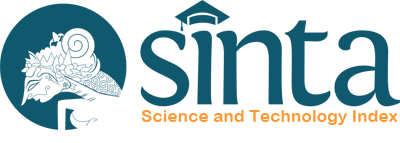Pengaruh Penggunaan Media Audio Visual terhadap Minat Belajar Siswa di MIM 1 PK Sukoharjo
DOI:
https://doi.org/10.28918/ijiee.v2i1.5275Keywords:
Audio visual media, Integrative thematic learningAbstract
Education is one of the driving factors for determining superior human resources for the progress of the nation. The existence of the media will help achieve goals more effectively and efficiently. Thematic learning is an integrated learning that uses a theme as the main focus and provides a meaningful experience for students as a whole. The low interest in students' learning as indicated by the value of students who have not achieved minimum mastery is the background of this research, so thatthe use of audio-visual media is examined for its influence on integrative thematic learning.This study uses a quantitative research approach with a descriptive correlation model and was carried out in February 2020 with a population of 210 students and a sample of 70students. The data collection techniques used observation, interviews, documentation and questionnaires. The results of this study concluded that: 1) the use of audio-visual media in integrative thematic learning was in the good category, with a percentage of 52.86% or 37 students, 2) students' interest in learning in integrative thematic learning was in the good category with a percentage of 48, 57% or 34 students, and 3) The use of audio-visual media has a positive effect on learning interest in integrative thematic learning with r0 = 0.624 greater than r1 at a significant level of 5% (r1 = 6.235) and 1% (r1 = 0.306). Madrasas are expected to learn more often using audio-visual media, especially material that may not be accessible to students' minds. Audio visual media learning can be applied at all grade levels.
References
Aliansyah, M. U., Mubarok, H., Maimunah, S., & Hamdiah, M. (2021). Pengaruh Media Pembelajaran Berbasis Audio Visual Terhadap Minat Belajar Siswa Di Pesantren Ainul Hasan. Jurnal Syntax Fusion, 1(07), 119-124.
Asnawir, B. U., & Usman, M. B. (2002). Media pembelajaran. Jakarta: Ciputat Pers. Azhar, A. (2011). Media Pengajaran. Jakarta: PT Raja Grafindo.
Faisal, S., & Lova, S. M. (2008). Pembelajaran Tematik di Sekolah Dasar. Medan: CV harapan cedas.
Haryoko, S. (2012). Efektivitas pemanfaatan media audio-visual sebagai alternatif optimalisasi model pembelajaran. Jurnal Edukasi Elektro, 5(1).
Rivai, A., & Sudjana, N. (2009). Media Pengajaran. Bandung: Sinar Baru Algensindo. Sisdiknas, U. U. (2003). UU No. 20 tahun 2003. Departemen Agama RI, Jakarta.
Sumanto, W. (2006). Psikologi Pendidikan Landasan Kerja Pemimpin Pendidikan. Jakarta, Rineka Cipta.
Tafonao, T. (2018). Peranan media pembelajaran dalam meningkatkan minat belajar mahasiswa. Jurnal Komunikasi Pendidikan, 2 (2), 103-114.
Trianto, M. P. (2010). Mengembangkan Model Pembelajaran Tematik. Jakarta: PT. Prestasi Pustakaraya.
Winkel, W. S., (2009). Psikologi Pengajaran. Cet. Ke-4. Jakarta: Grasindo.
Downloads
Published
Issue
Section
License
Copyright (c) 2022 Nur Hidayah, Lailla Hidayatul Amin, Wati Dwi Kasanah

This work is licensed under a Creative Commons Attribution 4.0 International License.
You are free to:
Share — copy and redistribute the material in any medium or format for any purpose, even commercially.
Adapt — remix, transform, and build upon the material for any purpose, even commercially.
The licensor cannot revoke these freedoms as long as you follow the license terms.
Under the following terms:
Attribution — You must give appropriate credit , provide a link to the license, and indicate if changes were made . You may do so in any reasonable manner, but not in any way that suggests the licensor endorses you or your use.
No additional restrictions — You may not apply legal terms or technological measures that legally restrict others from doing anything the license permits.
Notices:
You do not have to comply with the license for elements of the material in the public domain or where your use is permitted by an applicable exception or limitation .
No warranties are given. The license may not give you all of the permissions necessary for your intended use. For example, other rights such as publicity, privacy, or moral rights may limit how you use the material.














